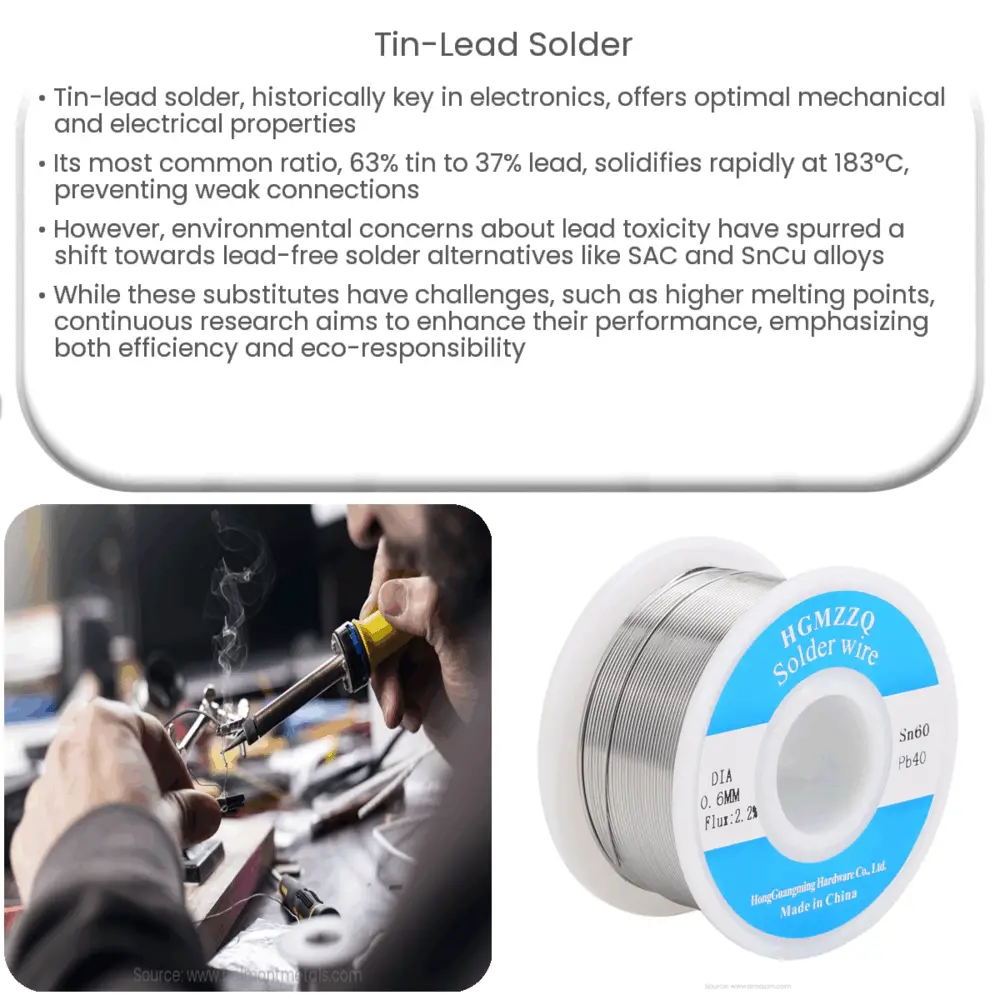Tin-lead solder, widely used in electronics, is known for its mechanical and electrical properties. Health concerns are driving a shift to lead-free alternatives.

Tin-Lead Solder: An Overview
Introduction
Tin-lead solder has been a staple in the electronics industry for decades, primarily used for joining electronic components to printed circuit boards (PCBs). It is a versatile alloy that offers a combination of excellent mechanical and electrical properties, making it a popular choice among engineers and manufacturers. In this article, we will explore the composition, properties, and applications of tin-lead solder, as well as its environmental impact and alternatives.
Composition and Properties
Tin-lead solder is an alloy made from a combination of tin (Sn) and lead (Pb), with the most common ratio being 63% tin and 37% lead, known as 63/37 or eutectic solder. This particular ratio is favored due to its unique eutectic point, which means it has a single melting point of 183°C (361°F) and solidifies rapidly without passing through a plastic or semi-solid state. This property helps reduce the risk of cold solder joints, which can lead to weak connections and potential failures in electronic devices.
Other popular tin-lead solder compositions include 60/40 (60% tin, 40% lead) and 62/36/2 (62% tin, 36% lead, 2% silver), both of which have slightly different melting points and properties. Tin contributes to the solder’s ability to wet and bond with metals, while lead provides ductility and lowers the melting point of the alloy.
Applications
Tin-lead solder is used extensively in the electronics industry to create durable, electrically conductive connections between components and PCBs. It is particularly well-suited for through-hole technology, where components are mounted on PCBs by inserting their leads through holes and soldering them in place. The solder also finds use in surface mount technology (SMT), where components are placed directly onto the surface of PCBs and soldered using solder paste or preformed solder balls.
Aside from its use in electronics, tin-lead solder has been employed in a variety of other applications, including plumbing, stained glass work, and jewelry making. However, due to health and environmental concerns, alternative solder materials have become more prevalent in these non-electronic industries.
Environmental Impact and Alternatives
The widespread use of tin-lead solder has raised concerns due to the toxic nature of lead, which can pose significant health risks to humans and the environment. As a result, many countries have implemented regulations to restrict the use of lead in various industries, including the European Union’s Restriction of Hazardous Substances (RoHS) directive, which prohibits the use of lead in electrical and electronic equipment.
In response to these regulations and growing environmental awareness, the electronics industry has shifted towards lead-free solder alternatives, such as tin-silver-copper (SAC) alloys and tin-copper (SnCu) alloys. These lead-free solders offer comparable performance to tin-lead solders but with a reduced environmental impact.
Performance of Lead-Free Solder Alternatives
While lead-free solders have made significant advancements in recent years, they are not without their challenges. One of the primary differences between tin-lead solder and lead-free alternatives is their higher melting points. For example, a common SAC alloy, SAC305 (96.5% tin, 3% silver, 0.5% copper), has a melting point of 217-220°C (423-428°F), which is notably higher than the 183°C (361°F) melting point of 63/37 tin-lead solder. This higher melting temperature can result in increased energy consumption during the soldering process and may require adjustments to manufacturing equipment and procedures.
Additionally, lead-free solders can exhibit different mechanical properties compared to their tin-lead counterparts. Some lead-free alloys may have reduced ductility, making them more prone to fatigue and potential failure under certain conditions. However, research and development efforts continue to improve the performance and reliability of lead-free solders, making them a viable alternative to traditional tin-lead solder in many applications.
Health and Safety Considerations
When working with tin-lead solder, it is essential to take appropriate health and safety precautions to minimize exposure to lead. This includes using proper ventilation, wearing personal protective equipment (PPE) such as gloves and safety glasses, and ensuring proper hygiene practices like washing hands thoroughly after handling solder. Additionally, proper disposal of solder waste and recycling of used solder materials can help reduce the environmental impact of tin-lead solder.
Conclusion
Tin-lead solder has played a crucial role in the electronics industry for many years, offering a combination of favorable mechanical and electrical properties. However, due to the environmental and health concerns associated with lead, the industry has been transitioning towards lead-free solder alternatives. While these alternatives may present certain challenges, ongoing research and development efforts continue to improve their performance and reliability, making them an increasingly viable option for various applications.
As the industry evolves and regulations continue to push for the adoption of more environmentally friendly materials, it is important for engineers and manufacturers to stay informed about the latest developments in solder technology. By doing so, they can make informed decisions about the best materials to use in their products, striking a balance between performance, reliability, and environmental responsibility.

